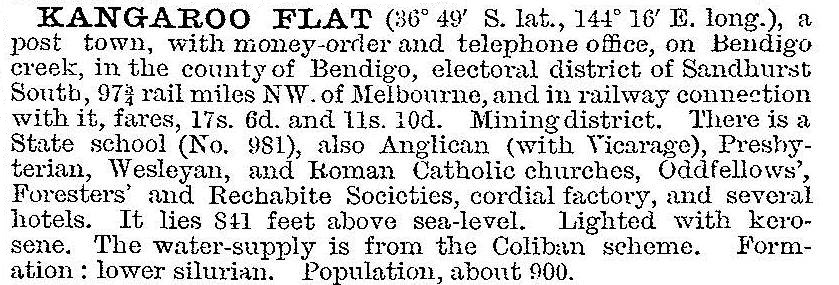Kangaroo Flat
Kangaroo Flat is a large suburb of Bendigo, 5 km south-west of the city centre.
The Bendigo Creek and some of its upstream tributaries flow through Kangaroo Flat, and it was along the Bendigo Creek about 4 km downstream (Golden Point) that Bendigo’s early gold mining was concentrated. There are reports of gold workings in Kangaroo Flat early in 1853, and it was the finding of the rich Crusoe gully west of Kangaroo Flat in mid-1853 that started a rush to the district. The Bendigo district’s largest gold nugget (377 ounces) was found near Crusoe Gully in 1861.
The area was first named Yankee Boat Flat, but the pursuit and capture of a kangaroo by miners apparently caused a change of name.
Wesleyan church services and a school began in 1854, as did Catholic services. Most mining was alluvial or by puddling machines until several companies began exploiting quartz reefs in 1871. By the mid-1860s there were Anglican and Wesleyan schools, seven hotels, a railway station on the Melbourne to Bendigo line (1862) and about 25 puddling machines at work. Kangaroo Flat was classified as a small postal township.
In 1873 the Crusoe water reservoir was completed in Crusoe gully, an important step towards permanent water for Kangaroo Flat and Bendigo. Permanent church buildings were completed for Anglicans (1862), Catholics (1864) and Methodists (1858 and 1871). There was sustained mining activity throughout the 1870s and 1880s, but the next two decades saw the population fall to about two-thirds of the peak census figure reached in 1881. In 1903 Kangaroo Flat was described in the Australian handbook:

Kangaroo Flat continued as a Bendigo outer suburb until the years following World War II, when postwar industries were attracted to it. A Dunlop belting factory opened in 1948 and Bradford Cotton Mill in 1950. The mill (later Rocklea Spinning Mill) employed 324 workers in 1964 and 230 in 1993. An egg-grading establishment, connected to extensive poultry farms in the area, was also opened. A technical school was opened in 1962. In 1979 the Lansell Plaza shopping centre, south of the original shopping strip, was opened. It has a discount department store, two supermarkets and 55 specialty shops occupying 16,865 sq m of floor space. In 1998 it was slightly larger than Bendigo’s other sub-regional drive-in shopping centre.
Kangaroo Flat has numerous sports clubs, a reserve with a leisure centre, oval and swimming pool, a Catholic school, a primary school (315 pupils, 2014), the state Crusoe secondary college (726 pupils, 2014) two hotels, three motels, local and sub-regional shopping centres and a caravan park (closed 2014).
Kangaroo Flat has three sites on the Victorian Heritage Register: the railway station complex (1862), the former common school (1870) and the Coliban water supply system which feeds into the Crusoe reservoir.
St Mary's Anglican church was destroyed by fire in 2008, and replaced by a new building which opened in 2014. Controversy arose in 2014 following the release of plans for a new indoor aquatic centre which involved the demolition of the existing community hall.
Kangaroo Flat’s census populations have been:
| census date | population |
|---|---|
| 1871 | 260 |
| 1881 | 1109 |
| 1891 | 635 |
| 1901 | 880 |
| 1921 | 830 |
| 1933 | 829 |
| 1947 | 1012 |
| 2006 | 8421 |
| 2011 | 9492 |
Further Reading
David G. Horsfall, Kangaroo Flat: a history, goats, gold and peppercorns, the author, 1993
Shire of Marong, 1864-1964, the Shire, 1964
Photographic history of Kangaroo Flat, Vols 1 and 2, 1993, 1994


